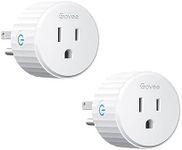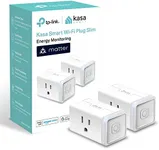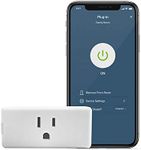Buying Guide for the Best smart plugs
Smart plugs are handy devices that let you control your regular appliances remotely using your smartphone or voice assistants. They can help you save energy, automate routines, and add convenience to your daily life. When choosing a smart plug, it's important to consider how you'll use it, what devices you'll connect, and how it will fit into your existing smart home setup. Understanding the key features will help you pick the best smart plug for your needs.CompatibilityCompatibility refers to whether the smart plug works with your existing devices and smart home systems, such as Amazon Alexa, Google Assistant, or Apple HomeKit. This is important because you want your smart plug to integrate smoothly with your current setup. Some plugs only work with certain platforms, so always check if the plug supports the voice assistant or app you plan to use. If you already use a specific smart home ecosystem, choose a plug that is designed to work with it for the best experience.
Wi-Fi FrequencyWi-Fi frequency indicates whether the smart plug connects to 2.4GHz, 5GHz, or both types of Wi-Fi networks. Most smart plugs use 2.4GHz because it has a longer range and better wall penetration, which is useful for devices placed far from your router. Some newer plugs support 5GHz, which can offer faster speeds but shorter range. If your home Wi-Fi is mostly 2.4GHz, almost any smart plug will work. If you have a dual-band router and want flexibility, look for plugs that support both frequencies.
Maximum Load/Power RatingThe maximum load or power rating tells you how much electrical current the smart plug can safely handle, usually measured in amps (A) or watts (W). This is crucial for safety and performance, as plugging in a device that draws more power than the plug can handle could cause overheating or damage. For small devices like lamps or fans, most standard plugs are sufficient. For larger appliances like heaters or air conditioners, check the power rating and make sure the plug can handle the load.
Size and Form FactorSize and form factor describe the physical dimensions and shape of the smart plug. This matters because some plugs are bulky and may block adjacent outlets, especially on power strips or wall sockets with limited space. If you plan to use multiple plugs side by side, look for compact or slim designs. Consider where you’ll be plugging it in and whether space is tight, as a smaller plug will be more versatile and less likely to get in the way.
Energy MonitoringEnergy monitoring is a feature that lets you track how much electricity your connected device is using. This can help you identify energy-hungry appliances and manage your power consumption more efficiently. If you’re interested in saving energy or want to monitor usage for budgeting or environmental reasons, choose a smart plug with built-in energy monitoring. If you just want basic remote control, this feature may not be necessary.
Scheduling and AutomationScheduling and automation allow you to set timers or routines for when your smart plug turns on or off. This is useful for automating lights, coffee makers, or other appliances to match your daily routine. Some plugs offer simple on/off schedules, while others support more advanced automation through apps or smart home platforms. If you want to automate your home or create routines, look for plugs with flexible scheduling options.
App Features and Ease of UseApp features and ease of use refer to how user-friendly the companion app is and what controls it offers. A good app should make it easy to set up the plug, control devices, set schedules, and check status. Some apps offer extra features like grouping multiple plugs or sharing control with family members. If you’re new to smart home devices, look for plugs with simple, well-reviewed apps to ensure a smooth experience.
















